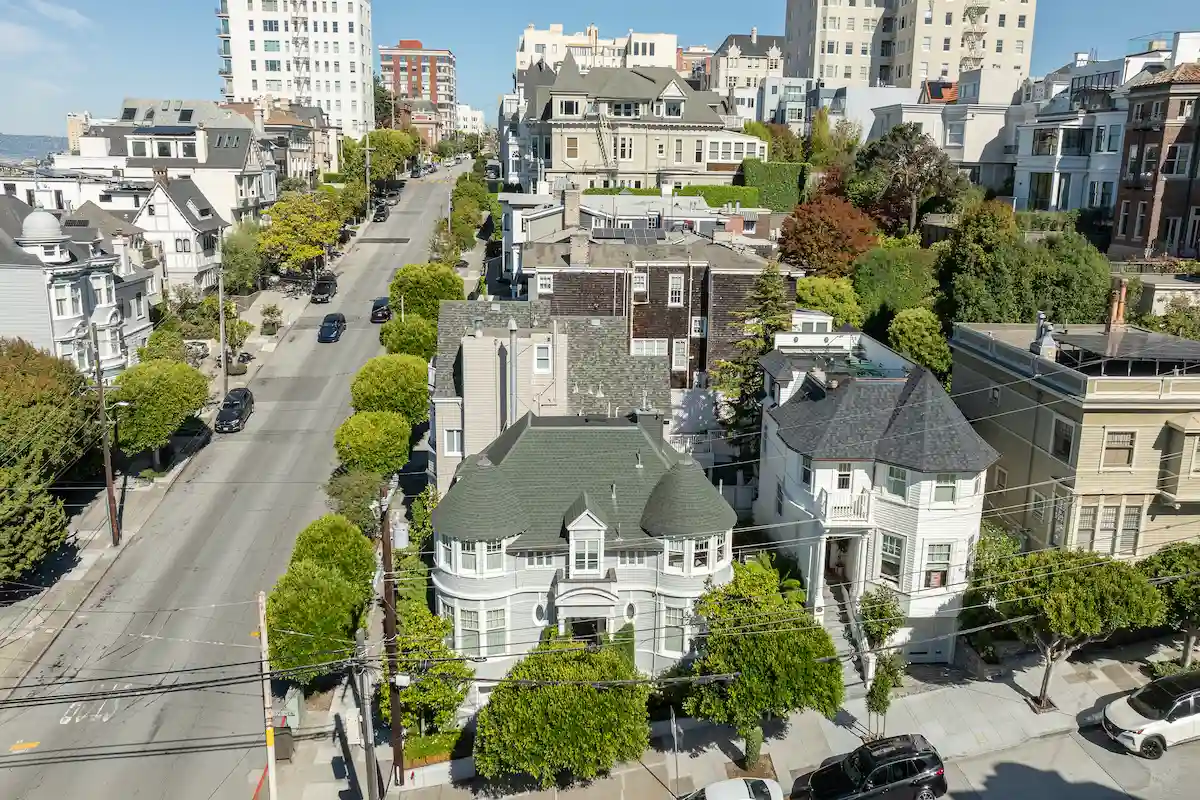Leading Bay Area Properties in Film and Television
Let’s look at several of the real estate properties that have played leading roles over the years. Has their worth or general appeal skyrocketed with fame? Whether chosen for their beauty, suburban charm, or quirky vibes, properties all across the Bay Area have had their moment in the limelight.
Here, in order of their film debut date, are ten properties in the broader East Bay and San Francisco area that have been featured as locations in film and television. You may be surprised how much their value has skyrocketed over the years!
The Maltese Falcon
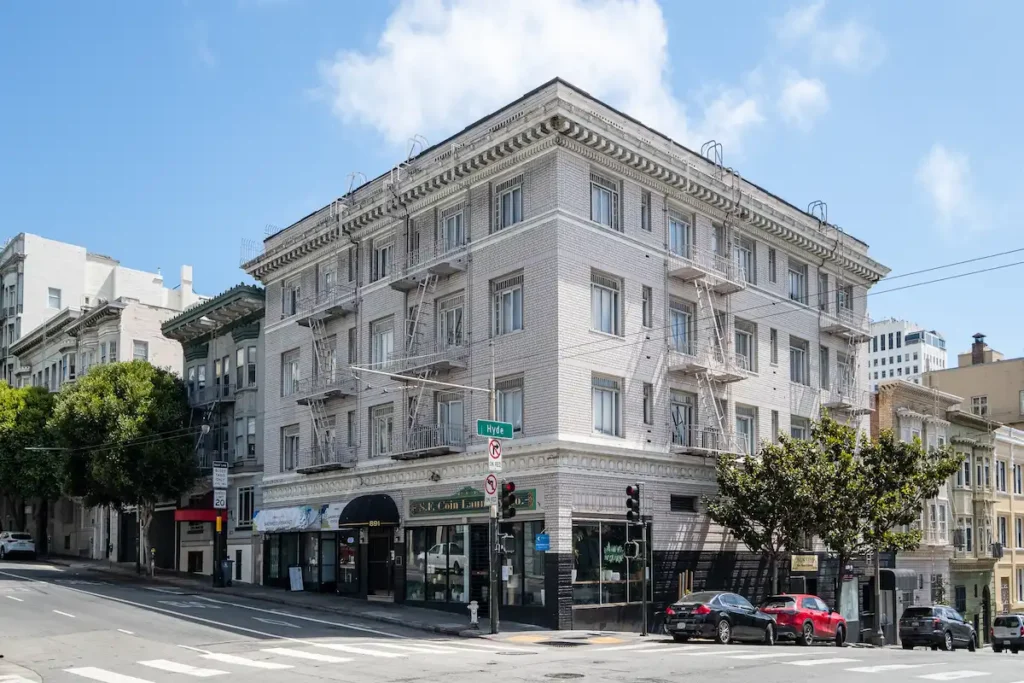
The Maltese Falcon Apartment: A Classic Noir Landmark on Post Street
- Price When Built: $17,000
- Price When Filmed: $35,000
- Price Today: $2.7M
Situated in the bustling Tenderloin district of San Francisco, the apartment building at 891 Post St is forever linked to the shadowy world of film noir, thanks to its role in the 1941 classic The Maltese Falcon. This building served as the residence of the film’s hard-boiled private detective, Sam Spade, played by the legendary Humphrey Bogart. As the setting for one of the most iconic films in American cinema, 891 Post Street has become a significant landmark for fans of the genre and for those who appreciate the rich history of San Francisco in the movies.
Built in the early 1920s, the building at 891 Post was originally designed as a residential space for the city’s growing population during a time of rapid urban development. At the time of its construction, the property would have been valued at around $15,000 to $20,000, reflecting its central location and the era’s architectural trends. By the time The Maltese Falcon was released in 1941, the building’s value had likely increased to approximately $35,000, coinciding with its place in the rapidly modernizing city.
Today, the building is estimated to be worth between $2.5 million and $3 million, a reflection of both skyrocketing S.F. property values and the apartment’s association with one of the most influential films of the 20th century. The multi-story building offers a glimpse into the urban life of a bygone era, with its narrow hallways and period details that evoke the atmosphere of classic noir films.
In The Maltese Falcon, the apartment at 891 Post St. plays a pivotal role, serving as the base of operations for Sam Spade as he navigates a web of intrigue, deception, and danger. The film’s moody lighting, sharp dialogue, and complex characters have made it a touchstone of the Noir genre, and the building’s connection to these elements has made it a point of interest for film buffs and history enthusiasts alike.
While the interiors in the film were created on a Hollywood soundstage, the exterior of this Post St. location is still recognizable to those who know the movie. Fans often visit this address to pay homage to the place where Sam Spade unraveled the mystery of the elusive black bird—the Maltese Falcon itself.
The “Maltese Falcon apartment” stands as a testament to the appeal of films noir and the city of San Francisco as a cinematic backdrop. From its early days as a simple apartment building to its status as a celebrated film location, this property has become an integral part of both the city’s cultural history and the legacy of one of Hollywood’s greatest films.
Vertigo
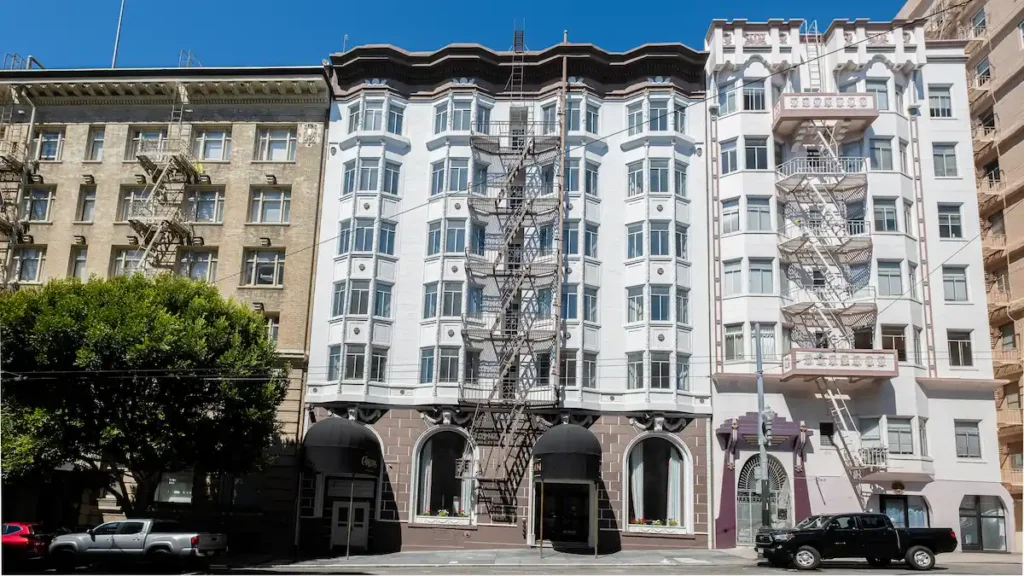
The Hotel Vertigo: A Cinematic Landmark at 940 Sutter Street
- Price When Built: $170,000
- Price When Filmed: $500,000
- Price Today: $14M
Located in San Francisco’s Lower Nob Hill neighborhood, the building at 940 Sutter Street has earned a unique place in cinematic history as the site of the Empire Hotel in Alfred Hitchcock’s 1958 classic Vertigo, starring James Stewart as John “Scottie” Ferguson. The hotel, where the character Judy Barton (played by Kim Novak) lived, became an iconic part of the film’s eerie atmosphere.
The building was originally constructed in 1922, designed as a stylish and affordable hotel in the heart of San Francisco. At the time of its construction, the property was likely valued at around $150,000 to $200,000, a reflection of both its prime downtown location and the elegant design that catered to travelers and residents alike.
By 1958, when Vertigo was filmed, the value of the Empire Hotel had increased significantly, with an estimated worth of around $500,000. This rise in value mirrored the growth of San Francisco as a major urban center, with properties in desirable neighborhoods like Lower Nob Hill seeing considerable appreciation.
Today, the Hotel is estimated to be worth between $15 million and $20 million, driven by the ongoing demand for real estate in San Francisco and the property’s unique place in film history. The building, with its classic 1920s architecture, offers guests a chance to experience the charm of a bygone era, while still enjoying the modern amenities of a boutique destination.
In Vertigo, the Empire Hotel’s exterior and some interior scenes were used to depict Judy Barton’s residence, contributing to the film’s tense and mysterious mood. The hotel’s connection to Vertigo is so strong that in 2009, the hotel was renamed Hotel Vertigo, embracing its role in one of Hitchcock’s most famous works.
The hotel lobby and staircase have retained much of their original design, making them recognizable to fans of the movie. These features have been preserved to maintain the building’s historical and cultural significance.
From its early days to its current status as Hotel Vertigo, the property at 940 Sutter Street stands as a testament to the enduring appeal of Vertigo and its place in the cultural landscape of San Francisco. It’s a must-visit destination for Hitchcock enthusiasts!
For movie buffs
In this film James Stewart is John “Scottie” Ferguson, a former police detective suffering from acrophobia and vertigo following a traumatic incident during a rooftop chase. Kim Novak is Madeleine Elster, the beautiful wife of a client who hires Scottie to follow her, suspecting she might be in danger. Novak also plays Judy Barton, whose role becomes central as the plot unfolds.
Scottie follows Madelaine around San Francisco and becomes increasingly obsessed with her. The film takes a turn as he deals with his phobias and his growing infatuation, leading to a complex web of deception, identity, and obsession. The story is famous for its intricate plot, and innovative use of color & camera techniques to simulate the disorienting sensation of vertigo.
Bullitt
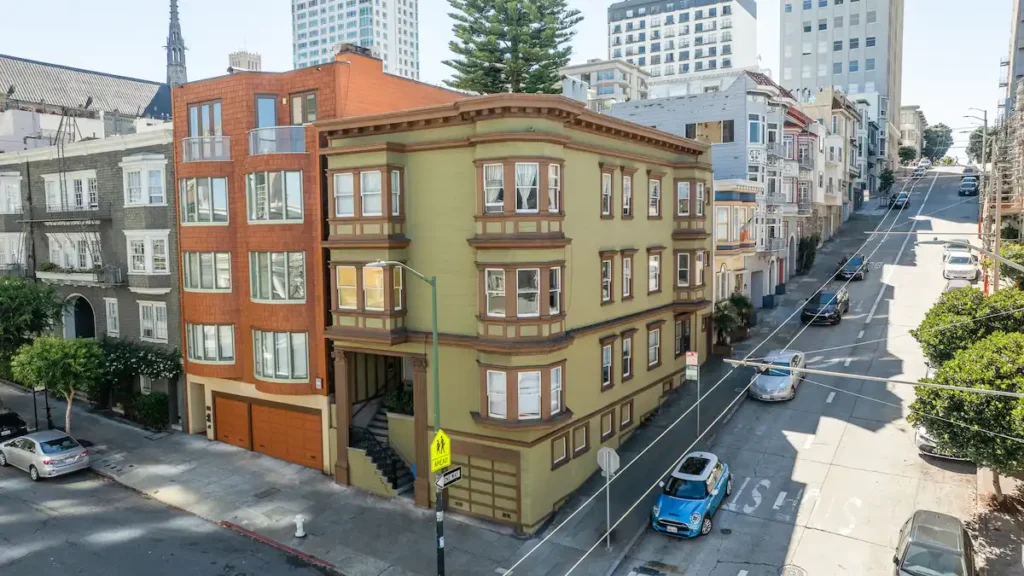
The Bullitt Apartment: A Mid-Century Modern Icon in Nob Hill
- Price When Built: $27,000
- Price When Filmed: $100,000
- Price Today: $2.5M
Perched on the steep slopes of San Francisco’s Nob Hill, the apartment building at 1153-57 Taylor Street is more than just a residence—it’s a piece of cinematic history immortalized in the 1968 film Bullitt. Starring Steve McQueen, this action-packed thriller is best known for its legendary car chase through the streets of San Francisco, and this unassuming building played a central role as the home of McQueen’s character, Lieutenant Frank Bullitt.
Constructed in the mid-20th century, this building exemplifies the clean lines and functional design characteristic of the era. At the time of its construction, the property was likely valued at around $25,000- $30,000, reflecting the growing demand for living space in the heart of the city. By 1968, when Bullitt was filmed, the value of the apartment building had likely risen to $100,000, buoyed by its prime location in such a desirable neighborhood.
Today, the property at 1153-57 Taylor Street is estimated between $2 million and $3 million, a testament to both the rapid appreciation of San Francisco real estate and the building’s place in film history. The multi-unit building, with its understated mid-century design, is known for its steepness and classic architecture, plus great visuals.
The scenes shot at this location in Bullitt capture the essence of 1960s San Francisco—a city known for its hills, unique architecture, and dynamic urban environment. The building is a point of interest for film enthusiasts who seek it out to pay homage to the film and its iconic star.
While interiors in Bullitt were likely filmed on a soundstage, the exterior of 1153-57 Taylor Street is instantly recognizable to fans of the movie who remember its role in one of the most thrilling sequences ever captured on film. This property is a quintessential example of how a film can elevate an ordinary location into an extraordinary piece of cultural heritage.
For movie buffs
Steve McQueen plays Lt. Frank Bullitt, a San Francisco police officer. The film follows him as he is tasked with protecting a witness in a high-profile case. When the witness is killed under his protection, Bullitt seeks out those responsible, leading to one of the most famous car chases in film history. Celebrated for its realism and style, particularly in its portrayal of police work and its innovative action sequences, this film, especially Steve McQueen’s performance, quickly became a classic.
Full House
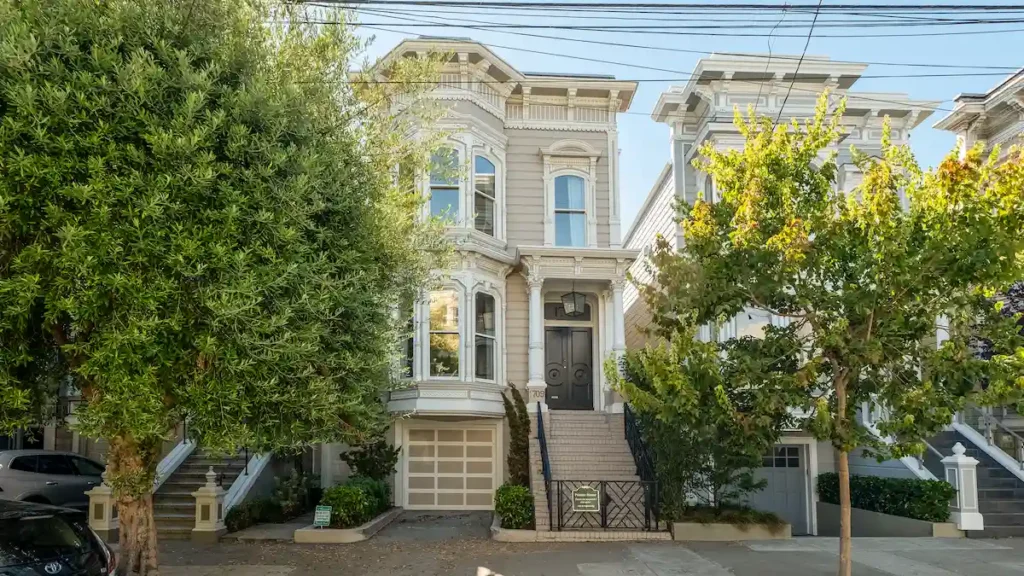
The Full House House: A Picture-Perfect Victorian
- Price When Built: $3,700
- Price When Filmed: $500,000
- Price Today: $5.25M
Nestled in the heart of San Francisco’s Pacific Heights neighborhood, the house at 1709 Broderick Street is more than just a beautiful Victorian—it’s a cultural landmark that has charmed millions of TV viewers around the world. Known to fans as the Tanner family home in the beloved sitcom Full House and its sequel Fuller House, this property has become one of the most recognizable residences in television history.
Built in 1883, this classic Victorian home originally reflected the grandeur of San Francisco’s architectural boom during the late 19th century. At the time of its construction, the house was likely valued at $3,500 to $4,000, a significant sum in that area. The neighborhood, known for its stunning views of the Bay and its elegant homes, was already one of the city’s most desirable locations.
By the time Full House debuted in 1987, the property’s value had increased substantially, with an estimated worth of approximately $500,000. The show’s popularity, which spanned eight seasons and a sequel series, brought global attention to the house at 1709 Broderick, making it a real destination for fans visiting San Francisco.
Today, the house is estimated to be worth between $5 million and $5.5 million, reflecting the city’s booming real estate market and the property’s enduring association with Full House. The home features quintessential Victorian elements like steep gables, decorative trim, and bay windows, and spans over 2,500 square feet offering a glimpse into the elegance of another era.
Though the TV interiors were filmed on a soundstage, the exterior of 1709 Broderick has become synonymous with the warm, family-friendly atmosphere that Full House is known for. It’s remarkable how a single property can capture the hearts of viewers and become an integral part of a show’s legacy.
About the series
Full House showcased the lives of a widowed father and his three daughters, helped by his brother-in-law and best friend. Their home became a symbol of ’90s family-friendly television and also enhanced San Francisco’s reputation as a family-centric city.
The Real World
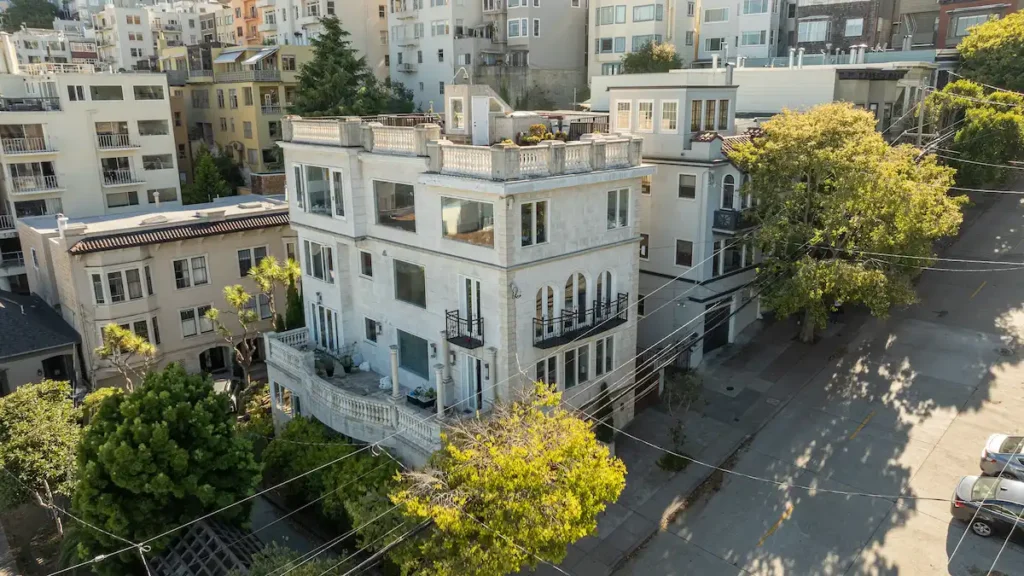
The Real World House: Reality TV on Lombard Street
- Price When Built: $27,000
- Price When Filmed: $1.5M
- Price Today: $5.5M
Located on one of the most famous streets in the world, the house at 949-953 Lombard Street in San Francisco is a landmark not only for its stunning architecture and prime location but also for its role in the history of reality television. This house was the setting for the 1994 season of The Real World: San Francisco, the third installment of MTV’s groundbreaking reality TV series that helped define a generation and shape the future of unscripted television.
Constructed in the early 20th century, the property at 949-953 Lombard Street reflects the elegant, multi-story design typical of San Francisco’s upscale neighborhoods such as The Marina or Cow Hollow. At the time of its construction, the house was likely valued at around $25,000 to $30,000, a figure that captured both the size and prestigious location of this property on “the crookedest street in the world.”
By 1994, when The Real World: San Francisco was filmed, the property already had jumped to an estimated value of $1.5 million. The house’s role in the show, which featured a group of young adults living together and navigating the complexities of life, love, and social issues, brought it into the spotlight. This season of The Real World was particularly notable for its candid exploration of topics like HIV/AIDS and LGBTQ+ rights, making the house a symbol of social awareness and cultural conversation.
Today, the house is estimated to be worth between $5 and $6 million, driven by the city’s soaring property values and its place in TV history. The multi-unit residence, with spacious interiors and classic San Francisco charm, continues to attract attention from fans of the show.
The Real World: San Francisco is remembered not just for its entertainment value but also for its impact on the way reality television could address real-world issues. The house at 949-953 Lombard Street was the backdrop for some of the most memorable moments in the series, including the life and struggles of cast member Pedro Zamora, an HIV/AIDS educator whose story touched millions and helped to change public perceptions.
Mrs. Doubtfire
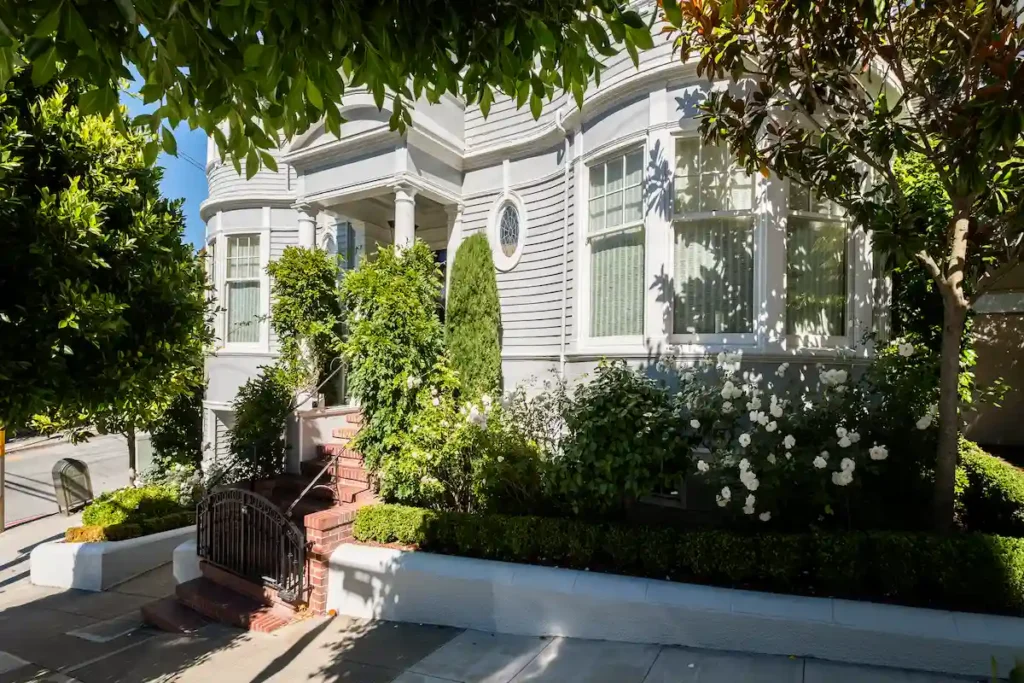
The Mrs. Doubtfire House: An Unforgettable Victorian in Pac Heights
- Price When Built: $2,200
- Price When Filmed: $249,000
- Price Today: $4.15M
Nestled at the corner of Steiner Street and Broadway in San Francisco’s prestigious Pacific Heights neighborhood, the house featured in the beloved 1993 comedy Mrs. Doubtfire has become a landmark in its own right. This iconic Victorian at 2640 Steiner St. has witnessed over a century of San Francisco history and a meteoric rise in value that would make any real estate investor swoon.
Built in 1893, this charming residence was likely valued at a modest $2,000 to $2,400 at the time of construction. Fast-forward a century to 1993, when Robin Williams donned his unforgettable nanny disguise, and the property’s value skyrocketed to approximately $249,170.
Today, this slice of cinematic history is estimated to be worth between $5.2 million and $5.5 million–a testament to both San Francisco’s booming real estate market and the enduring appeal of movie magic.
In the world of real estate, location is everything, and this property’s cinematic pedigree has only enhanced its value. The five-bedroom, four-bathroom home spans an impressive 3,300 square feet, offering breathtaking views down Steiner St. to San Francisco Bay.
After Robin Williams’ untimely passing in 2014, the house became an impromptu memorial site, with fans leaving flowers and mementos on the doorstep. This outpouring of affection highlighted the deep connection people feel to the locations where their favorite stories unfold. The property’s most recent sale in 2016 for $4.15 million marked another chapter in its storied history.
The “Mrs. Doubtfire House” remains a shining example of how a property’s cultural significance can dramatically influence its market value. From its humble beginnings as a Victorian family home to its current status as a must-see spot for movie enthusiasts, this house embodies the dream of owning a piece of Hollywood history–right in the heart of San Francisco.
So I Married an Axe Murderer
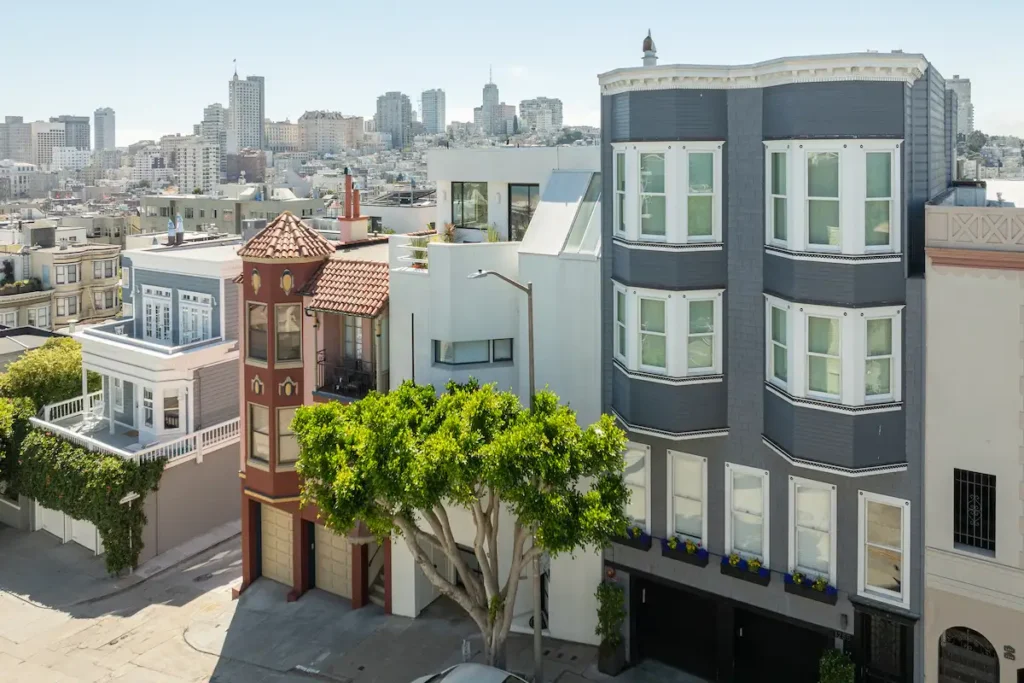
The So I Married an Axe Murderer Apartment: A Quirky Landmark on Russian Hill
- Price When Built: $13,000
- Price When Filmed: $600,000
- Price Today: $3.7M
Perched on the scenic slopes of Russian Hill, the apartment at 1245 Montgomery Street is more than just a residence—it’s a quirky piece of San Francisco’s cinematic history. Featured in the 1993 cult classic So I Married an Axe Murderer, this apartment served as the home of Charlie Mackenzie, the film’s protagonist, played by Mike Myers. With its distinctive charm and stunning views of the Bay, the property perfectly captures the offbeat humor and unique character of the movie.
The building at 1245 Montgomery St. was constructed in the early 20th century, during a period when Russian Hill was becoming one of San Francisco’s most desirable neighborhoods. Originally, the property would have been valued at around $10,000 to $15,000, a reflection of its prime location and architectural prowess. By the early 1990s, when So I Married an Axe Murderer was filmed, the apartment’s value had increased significantly, with an estimated worth of approximately $600,000, driven by the ever-growing demand in this neighborhood.
Today, the apartment is estimated to be worth between $3.5 and $4 million, thanks to market appreciation and film lore. The building, with its classic San Francisco facade, offers breathtaking views of Coit Tower, the Bay, and the city’s unique skyline, making it a highly sought-after location.
In So I Married an Axe Murderer, the apartment at 1245 Montgomery Street plays a central role in the film’s storyline, serving as the backdrop for many of the movie’s memorable scenes. The property’s quirky, yet cozy, atmosphere perfectly complements the film’s blend of comedy, romance, and mystery, making it an ideal setting for Charlie’s offbeat adventures in love.
The apartment’s exterior remains largely unchanged since the film was made. Visitors to Russian Hill seek out this address, drawn by the opportunity to see a piece of movie history in one of the city’s most picturesque neighborhoods.
For movie buffs
This cult classic, known for its dark humor and different take on the romantic comedy genre, is the story of a man who suspects his new bride might be a serial killer. Yikes! Russian Hill’s picturesque streets and famous landmarks like Lombard St, were key features of the film. That neighborhood has always been desirable, but you can see how real estate values have jumped significantly since 1993 when So I Married an Axe Murderer was released.
The tech industry’s explosive growth and San Francisco’s limited housing supply has driven prices upward. Also, over the years, Russian Hill homes have been renovated, adding to their value. So I Married an Axe Murderer showcased Russian Hill at a time when San Francisco was already a sought-after but accessible market. The ensuing decades have seen the neighborhood become a lot more expensive. Charlie Mackenzie’s apartment may have cost around $500,000+ in the early 1990s, but today it would be several million.
The Parent Trap
The Staglin Family Vineyard: A Starring Role in “The Parent Trap”
- Price When Built: $34 per acre
- Price When Filmed: $12M per acre
- Price Today: $35M per acre
Tucked in the picturesque Rutherford region of Napa Valley, the Staglin Family Vineyard is not just a premier winemaking destination; it’s also a cinematic landmark, thanks to its role in the 1998 remake of The Parent Trap. This idyllic vineyard, with its stunning Mediterranean style estate, served as the picturesque backdrop for the home of Nick Parker, the character played by Dennis Quaid.
Established in 1985, the Staglin Family Vineyard has a reputation for producing some of the finest wines in Napa Valley. However, its cinematic history dates back to 1998 when it was chosen as the location for The Parent Trap. The property’s timeless beauty and serene atmosphere made it the perfect setting for the film’s pivotal scenes, where twin sisters, played by Lindsay Lohan, meet for the first time and plot to reunite their parents.
The property was originally part of a large tract of land purchased in 1864 by pioneering settler John Steckter, and his wife, Mary E. Harris Steckter. As Napa Valley was transforming from an uninhabited area to an agricultural hub, acquiring land for $34 an acre was not uncommon.
By the late 1880s, the Valley was becoming known as a wine-growing region. The property that would later become Staglin Family Vineyard saw its first plantings of grapevines during this period, as European immigrants with winemaking expertise began to arrive.
Many years after Prohibition, in 1985, Garen and Shari Staglin purchased the property and founded the Staglin Family Vineyard. They replanted the vineyards and invested in sustainable farming practices and have gone on to produce world-class wines.
At the time of the film’s release, the estate was already a well-known name in the world of wine, but its appearance in this movie introduced it to a broader audience. The estate’s value, tied closely to the success of the vineyard and the prestige of its Napa location, was likely in the range of $10 million to $15 million at that time. Today, the Staglin Family Vineyard is worth significantly more, with estimates ranging from $30 million to $40 million, considering its continued success as a premier winemaking establishment and its added value as a part of film history. The Mediterranean style villa that serves as the family home in the film remains one of the vineyard’s most stunning features, with its sprawling gardens, and breathtaking views.
Visitors often come to the vineyard not just for the exceptional wines, but also to experience a piece of movie magic in one of the most beautiful settings in California. The Parent Trap certainly enhanced its allure, making it a must-visit destination for oenophiles and movie enthusiasts alike.
The film stars Lindsay Lohan, Dennis Quaid, and Natasha Richardson in a tale of twin sisters, separated at birth and each raised by one of their biological parents, who accidentally meet at summer camp and concoct a plan to bring their parents back together.
The Princess Diaries
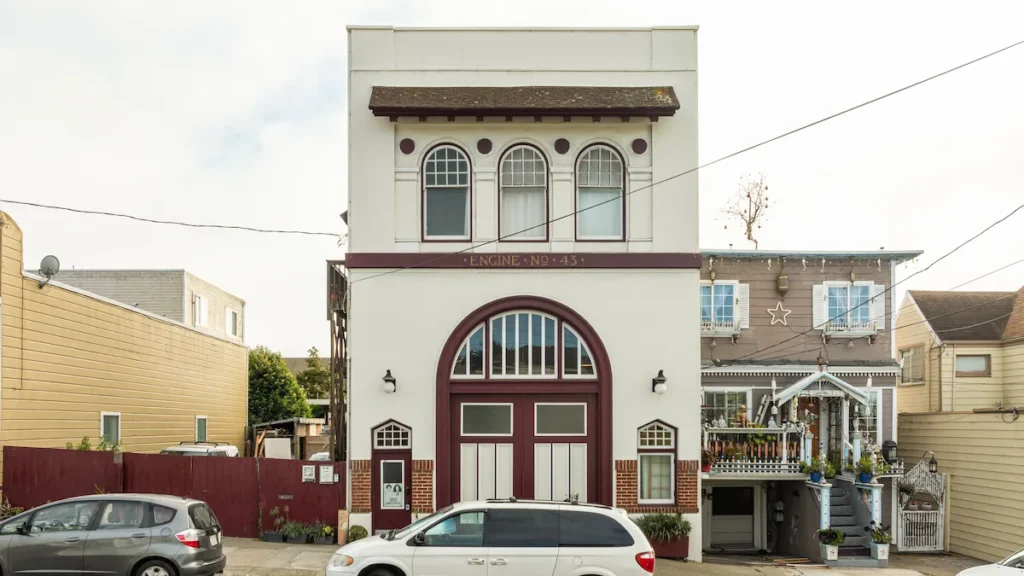
The Princess Diaries House: Hidden in the Excelsior District of S.F.
- Price When Built: $4,500
- Price When Filmed: $400,000
- Price Today: $1.3M
Located in San Francisco’s diverse Excelsior district, the house at 724 Brazil Avenue holds a special place in cinematic history as the setting for the 2001 family comedy The Princess Diaries. This unassuming home was where Anne Hathaway, in her breakout role as Mia Thermopolis, began her transformation from an ordinary teenager to the princess of Genovia. Despite its modest exterior, this property has become a beloved piece of Hollywood lore, thanks to its association with this charming film.
Originally built in the early 20th century, the house at 724 Brazil Avenue was likely valued at around $4,000 to $5,000 during its construction—a modest sum reflective of the working-class neighborhood in which it resides. By the time The Princess Diaries was filmed in 2001, the property’s value had increased to approximately $400,000, aligning with the steady growth of San Francisco’s real estate market over the decades.
Today, the house is estimated to be worth between $1.2 million and $1.5 million, a reflection of both San Francisco’s booming real estate market and the home’s connection to a beloved family film. The three-bedroom, two-bathroom home spans approximately 1,400 square feet, offering a cozy, yet classic, San Francisco charm that has endured through the years.
While the house might not be as grand as Mia’s Genovian palace, its role in The Princess Diaries has made it a point of interest for fans of the movie. This unpretentious residence stands as a reminder that even the most ordinary places can become extraordinary through the magic of cinema. Indeed, 724 Brazil Avenue showcases how a humble family home can gain cultural significance and rise in value, thanks to its silver screen debut.
For movie buffs: Directed by Garry Marshall, this family comedy stars Hathaway as Mia Thermopolis, a shy high school student who discovers that she is heir to the throne of a small European principality called Genovia. Julie Andrews plays her grandmother, Queen Clarisse Renaldi, who arrives to give her “princess lessons”. In the movie, 724 Brazil Avenue is the home of Mia Thermopolis and her mother. This bohemian firehouse-turned-residence reflects the characters’ unique and artistic lifestyle. The house plays a big role in the film, serving as the backdrop for many key scenes. The house, with its distinctive features, plays into the film’s narrative of transformation and identity, making it an integral part of Mia’s journey from an awkward teenager to a confident princess.
The Social Network
The Social Network House: A Modern Classic on Telegraph Hill
- Price When Built: $22,000
- Price When Filmed: $1.5M
- Price Today: $3.7M
Located in the picturesque neighborhood of Telegraph Hill, the house at 742 Greenwich Street was a modern landmark with a unique connection to the film The Social Network. This 2010 drama, which chronicles the creation of Facebook, used this San Francisco residence to depict the early days of Mark Zuckerberg’s revolutionary startup. While much of the film is set at Harvard, this house plays a crucial role in capturing the spirit of innovation that defines Silicon Valley and the tech world.
The property at 742 Greenwich Street, built in the mid-20th century, originally reflected the modest charm of its time, likely valued at around $20,000 to $25,000 during its construction. By the time The Social Network was filmed, the property had appreciated significantly, with an estimated value of approximately $1.5 million. This increase mirrored the overall growth in San Francisco’s real estate market, driven by its proximity to the burgeoning tech industry and the city’s continued desirability as a place to live and work.
Today, 742 Greenwich Street is estimated to be worth between $3.5 million and $4 million, a testament to both San Francisco’s ever-climbing property values and the home’s brush with cinematic fame. The house, which offers stunning views of the Bay Area and the iconic Coit Tower, spans over 2,500 square feet and features multiple levels that make the most of its prime Telegraph Hill location.
In The Social Network, the house at 742 Greenwich Street represents more than just a residence—it symbolizes the humble beginnings of a tech empire that would change the world. The scenes shot here capture the energy and ambition of young entrepreneurs on the brink of creating something monumental, a fitting backdrop for a story about innovation and success.
As a piece of both cinematic and technological history, 742 Greenwich Street remains a sought-after property in one of San Francisco’s most desirable neighborhoods. The home’s association with The Social Network has only added to its allure, making it a point of interest for movie buffs and tech enthusiasts alike. From its origins as a modest mid-century home to its current status as a modern classic, this property embodies the spirit of a city that continues to shape the future.
For movie buffs: This critically acclaimed 2010 film written by Aaron Sorkin offers a dramatized account of the founding of Facebook and the legal battles that followed. It’s based on the book “The Accidental Billionaires” by Ben Mezrich. The home where Mark Zuckerberg and his team lived and worked in the film is at 742 Greenwich Street, in San Francisco.
The narrative is structured around two major lawsuits: one by Facebook co-founder Eduardo Saverin (played by Andrew Garfield) and another by the Winklevoss twins (both played by Armie Hammer), who claim that Zuckerberg stole their idea. The film offers insights into the cutthroat nature of Silicon Valley startups and the complex dynamics of friendship, betrayal, and business in the digital age. It received multiple awards, including three Academy Awards: Best Adapted Screenplay, Best Original Score, and Best Film Editing.
The property at 742 Greenwich Street in San Francisco serves as the backdrop where Zuckerberg and his team move to work on Facebook after its initial success at Harvard. The house used in the film represents a typical San Francisco home that would be characteristic of the area’s residential architecture.
FAQ: Bay Area Real Estate in TV and Cinema
1. What is the historical significance of the apartment building at 891 Post Street in The Maltese Falcon?
- The apartment at 891 Post Street in San Francisco served as the residence of Sam Spade, the private detective played by Humphrey Bogart in the 1941 classic The Maltese Falcon. The building is a key location in the film noir genre and a landmark for fans of classic cinema.
2. How did the value of the Hotel Vertigo (formerly the Empire Hotel) change after its appearance in Vertigo?
- The Hotel Vertigo, originally the Empire Hotel, saw significant appreciation in value after its appearance in Alfred Hitchcock’s Vertigo. Built in 1922, its estimated worth rose from around $500,000 in 1958 to between $15 million and $20 million today, due in part to its cinematic legacy.
3. What makes the apartment building at 1153-57 Taylor Street iconic in the film Bullitt?
- The apartment at 1153-57 Taylor Street in San Francisco’s Nob Hill neighborhood became iconic after its role in the 1968 film Bullitt, starring Steve McQueen. The building is particularly famous for its connection to the film’s legendary car chase scene.
4. How has the value of the Full House house at 1709 Broderick Street changed over time?
- The Victorian home at 1709 Broderick Street, known for its role in the TV show Full House, has seen its value rise from around $500,000 in 1987 to between $5 million and $5.5 million today, reflecting its iconic status in television history.
5. What is the significance of 949-953 Lombard Street in San Francisco?
- The house at 949-953 Lombard Street was the setting for The Real World: San Francisco in 1994. It’s notable for its role in reality TV history and its location on one of the world’s most famous streets, “the crookedest street in the world.”
6. Why is the house at 2640 Steiner Street famous?
- The house at 2640 Steiner Street in San Francisco’s Pacific Heights became famous as the home of Robin Williams’ character in the 1993 film Mrs. Doubtfire. The Victorian house has since become a beloved landmark and a popular tourist attraction.
7. How did the apartment at 1245 Montgomery Street become associated with So I Married an Axe Murderer?
- The apartment at 1245 Montgomery Street on Russian Hill is featured in the 1993 cult classic So I Married an Axe Murderer. The property is known for its quirky charm and stunning views, which made it a perfect fit for the film’s offbeat humor.
8. What role did the Staglin Family Vineyard play in The Parent Trap?
- The Staglin Family Vineyard in Napa Valley was featured in the 1998 remake of The Parent Trap. The vineyard served as the setting for the home of Nick Parker, played by Dennis Quaid, and has since become a destination for movie fans and wine enthusiasts alike.
9. How has the property at 724 Brazil Avenue in San Francisco been impacted by its appearance in The Princess Diaries?
- The house at 724 Brazil Avenue, featured in The Princess Diaries (2001), has become a beloved cinematic location. Its value has increased significantly, reflecting both the real estate market and its connection to this popular family film.
10. What is the significance of 742 Greenwich Street in The Social Network?
- The house at 742 Greenwich Street in San Francisco was used in The Social Network (2010) to depict the early days of Facebook. This property symbolizes the birthplace of a tech empire and has become a point of interest for both movie buffs and tech enthusiasts.

